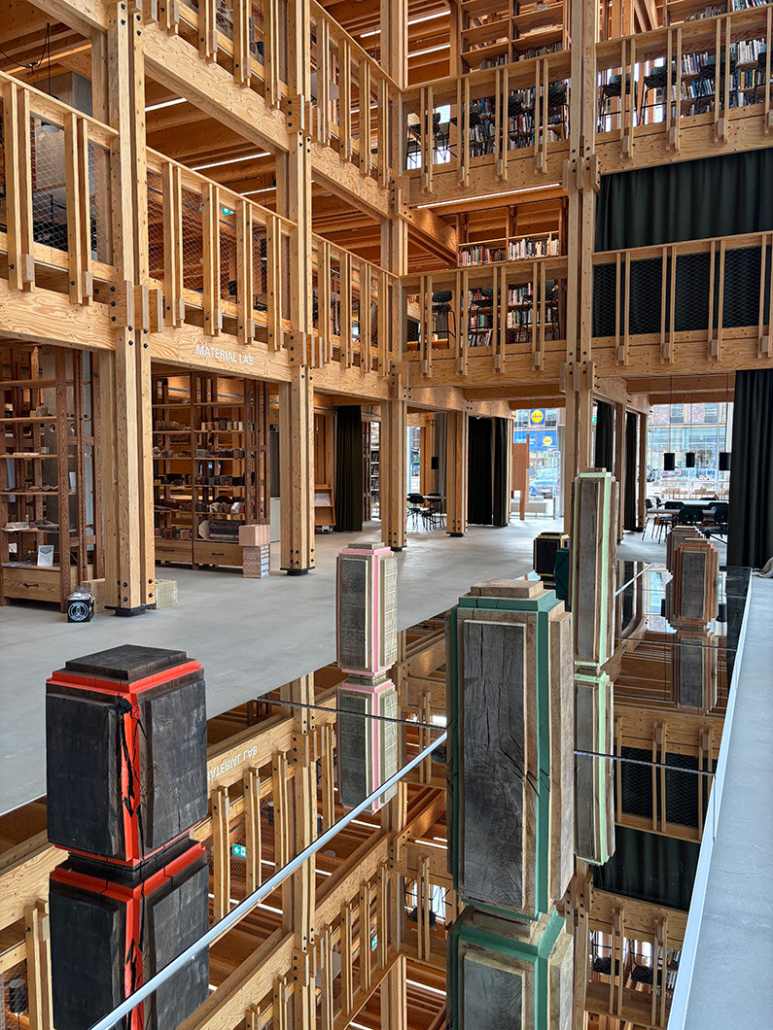Carlo, my friend
What happens when the corners and edges are removed from the roughly carved blocks and replaced with imaginary corners? How does this affect the experience of form, and what happens when the missing corners are colored or gilded?
Seven Blocks
Associate Professor Anders Gammelgaard is behind this exhibition, which can be experienced in the school’s Library until March 17 – everyone is welcome.
The seven blocks, which are made of oak, are to be seen as an examination of Carlo Scarpa’s ‘stepped’ transitions from Tomba Brion. What happens when corners and edges are removed from the roughly carved blocks and replaced with imaginary corners? How does this affect the perception of form, and what happens when the missing corners are colored or gilded? Finally, the seven blocks are a tribute to Carlo Scarpa.
The Hole
It is a hole in the middle of Carlo Scarpa’s gravestone. Or rather, the hole is offset from the center and surrounded by three concentric circular rings. The hole in the stone appears compelling. The gaze is drawn into the hole and disappears into darkness and nothingness. The gravestone is carved from marble, but right around the hole the material changes to concrete. The marble’s form creates a cavity that the concrete occupies in its liquid state. According to tradition, the name and the dates of birth and death are engraved in the gravestone. The inscription, together with a sequence of ornaments, forms a composition that begins at the edge of the gravestone and culminates at the black hole.
In many ways, the hole in the stone represents something central to Carlo Scarpa’s work; the detail reflects the whole, and the whole is captured in the detail. This continues in the meeting of materials, which takes place as a mutual staging. The marble stages the cast concrete, which in turn stages the hole, which ultimately stages the absent material. The black hole with its nothingness becomes the culmination of the materials’ interplay.
In the absence, the imaginary arises—what is, yet is not there. That which does not appear as a physical phenomenon but remains an abstraction. The paradox that Carlo Scarpa masters so sublimely, where the imaginary only becomes apparent through the material. At the entrance gate to the architecture school in Venice, he expresses this by having the Latin phrase engraved in the marble: Verum Ipsum Factum – truth through making.
The Edge
In Carlo Scarpa’s work, the ‘edge problem’ constitutes a recurring issue. With inspiration from the Baroque’s treatment of the transitions between spatial surfaces, he discusses the ‘edge problem’ as an imaginary meeting between surfaces. This is to be understood as a replacement of a concrete, physical edge with the idea of a meeting between surfaces. The edge no longer exists as a phenomenon, yet we still perceive it imaginatively. In Tomba Brion, Carlo Scarpa unfolds the imaginary corner in full force, as the edges of the in-situ cast concrete are not merely removed but are replaced by ‘stepped’ sequences. Thus, not just one imaginary meeting emerges, but rather an entire series of imaginary corners and edges. In addition, Carlo Scarpa gilds the inward-facing corners, which enhances the perception that the physical corner has been cut away and that the concrete contains an inner substance.



